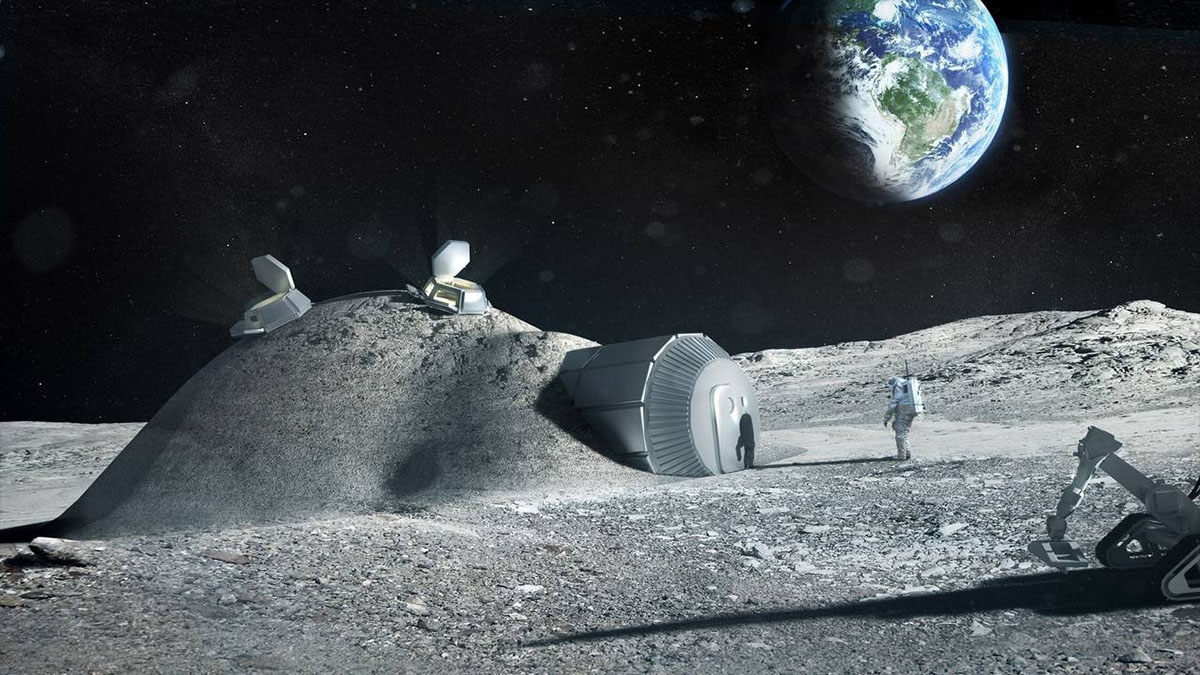fly me to the moon and print me an outpost

By now it’s hard to argue that modern 3D printing isn’t one of the hottest and most useful trends in engineering today and in the next five to ten years could well change the balance of powers in global manufacturing. Why deal with customs, foreign officials on the take just looking to dip into your business model to make a knock-off or wrest control of your factory on their soil when you could simply print superior, higher quality designs in your own lab? But that’s not the only thing that’s got engineers and high-minded VCs excited about 3D printing. It turns out that you could print your own Moon base and there are now two architectural firms pitching a design for sleek, futuristic habitats on the lunar surface using regolith. Why fly your habitats to another world and work in tiny, cramped spaces until you can chain more of them together when you can send an intelligent swarm of remote-controlled robots to print you a roomy base when you get there?
This is another reason why instead of aiming for our triumphant pre-victory lap around Mars, we should get back to the Moon because while we’ve been there, we haven’t done it all and printing lunar bases can translate into printing habitats on Mars. True, just because you could heat up a chunk of lunar regolith with microwaves and fuse it into a solid smooth, safe wall that will protect astronauts against radiation and extreme temperatures does not necessarily mean that Martian regolith would behave exactly the same way. But we do know enough about the composition of the red planet to make the necessary little tweaks in the process and construct resilient, roomy habitats before the astronauts even get there. Though there is the catch that building on Mars with remote-controlled robots involves a significant lag from Earth so the best method may be to send a space station with a compliment of engineers to closely watch the robots’ work and pitch in when something goes wrong or the process needs to deviate from the plan.
It wouldn’t be the cheapest method, but it would be quite efficient and get the bases built pretty quickly. On top of that, 3D printing your alien outpost gives you the freedom to create shapes that aren’t only functional and aesthetically pleasing, but uniquely suited to the world on which you’re now living. Sleek shapes on Mars virtually grown out of the rocks below mean resistance to powerful wind storms, while large, leaf-like forests of solar panels on the Moon mean catching as much solar energy as needed with the capacity to generate even more as the base grows. If we tried to completely 3D print homes and skyscrapers on Earth, things like zoning laws and the construction industry’s lag behind the cutting edge to save costs would quickly get in the way of completely new kinds of urban development. But in space, where 3D printing means invaluable creature comforts and protection for astronauts with the only zoning restriction being a lack of a military base on an alien world, this approach makes a lot of sense and can drive demand for 3D printed structures here after showing their utility and strength in harsh wastelands.
Suddenly, people might wonder what a 3D printed condo that can withstand a hurricane costs to build, and residents of skyscrapers in South Korea very unhappy with the swaying that happens during monsoons and architects trying to build higher and higher might be interested in growing a new building rather than come up with ever more complex stabilizers and aerodynamic shapes for their structures. There’s certainly precedent for a major space effort resulting in interest in a new kind of technology. After integrated circuits got Apollo to the Moon and back, chip makers used the lessons learned to build modern electronics like powerful desktops, laptops, and even portable music players. Perhaps 3D printing in space for scientists and tourists funded by starry eyed businesspeople like Musk, Tito, Branson, and Bigelow could provide a huge push for new generations of efficient, disaster-resistant cities on Earth while helping us achieve our dreams of solar system exploration? Maybe I’m a dreamer, but this doesn’t seem too far fetched to me…





